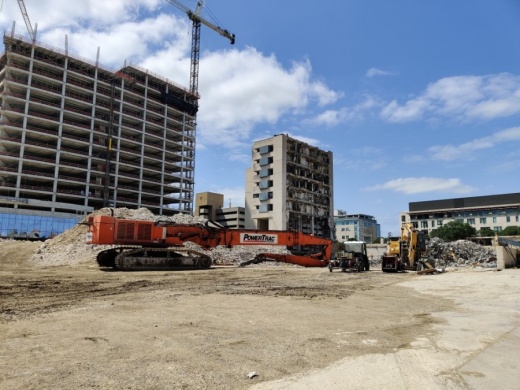The 14.34-acre property owned by the Travis County Healthcare District, or Central Health, is situated north of 12th Street and bounded by the I-35 frontage road and Red River and 15th streets. Central Health's proposed planned unit development, or PUD, rezoning of the site passed through the Austin Planning Commission 10-0-2 May 11 and is slated for a public hearing before City Council May 20.
The redevelopment of the former hospital property into a mixed-use commercial center has been eyed by Central Health, City Council and community stakeholders for years both as an enhancement to the downtown landscape and as a revenue driver for Central Health's work serving low-income county residents. The Central Health site, along with adjacent Waterloo Park and the university and medical district north of 15th Street, make up the northeast downtown innovation district as outlined by the Capital City Innovation nonprofit.
"It’s been really important to Central Health to continue to listen to the community and absorb their vision for what they want at this location. It is such a critical location in Austin’s growing health care arena, just the location to the hospital, the location to the medical school, and the fact that it is really this cornerstone for the innovation district," said Ted Burton, vice president of communications at Central Health.
Broad plans for the Brackenridge campus and downtown innovation district have been on the table for years, and the site's path to redevelopment accelerated in 2019 when council directed the start of a code amendment process to facilitate the creation of a new commercial center on the site. However, that process was halted last year in favor of the current PUD rezoning that could move closer to council's final approval later this month.
Around 1.2 acres of the site have already been dedicated for use by The University of Texas Dell Medical School. A 17-story office tower was announced in August 2019 as an initial anchor to the Central Health site, and construction of that building is well underway.
The tower project was launched after the nonprofit 2033 Higher Education Development Foundation signed a 99-year ground lease for a portion of the Central Health site, an agreement Burton said has already provided around $1.5 million to Central Health in line with the district's revenue generation objective.
As of May, no additional tenants have been locked in to occupy the mixed-use district. However, the vision for the site outlined by Central Health and community participants calls for a walkable mixed-use space that could incorporate retail, restaurant, office and housing. Burton also said health care companies may be targeted as occupants to align with Central Health's mission the medical slant of the innovation district.
While the remainder of the site's uses have yet to be confirmed, Central Health is working to prepare the property for new development. Demolition of the old Brackenridge hospital is nearly complete, Burton said, and the removal of existing structures that will not support new tenants in the future is continuing to provide a "clean slate" for developers.
“We don’t know exactly what will end up there, things have changed even over the course of the last few years," he said. “Nothing is off the table, it’s just too early to tell."
Red River realignment
One additional piece of the site's development plans is the realignment of Red River Street between 12th and 15th streets. The road currently includes a dog-leg at its junction with 15th and runs adjacent to Waterloo Park's property; Central Health is now planning to connect Red River through the redeveloped site to directly align with its northern and southern extents.
Nikelle Meade, a Husch Blackwell partner representing the health district, said during the May 11 Planning Commission meeting that an agreement with Austin will see Central Health design and construct the realigned Red River in exchange for a portion of the street's current path. After its realignment, the remainder of old Red River would be used as an "accessory" to the Waterloo Park and greenway projects, Meade said.
"Roughly speaking is, what would happen, where the road parallels the park along the creek, the city would get some of that property back," said Jerry Rusthoven, the Austin Housing and Planning Department case manager for the site's PUD process. "It wouldn't necessarily be dedicated to parkland because that would allow for a greater variety of things to be put there ... It would be available for public use, and we’d work with the Waterloo Greenway people on that."





